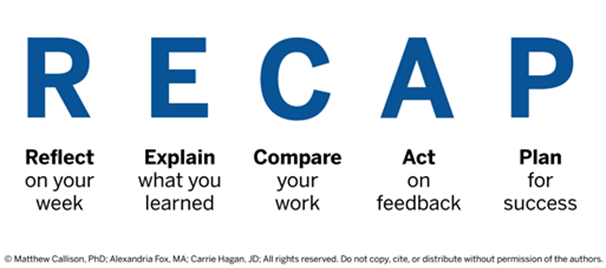Images and Videos of
Context
As students are completing modules and assignments, it is important for them to reflect on the work they have completed prior to moving on to next steps of an assignment or a new module. Therefore, RECAP walks students through a structured reflection process. Additionally, instructor presence and opportunities for just-in-time feedback in a face-to-face course is taken for granted. By providing a weekly structured feedback exercise, this enables faculty to have a weekly presence in the course and students are able to use the feedback and their self-reflection to plan for successes in the course.
Description
For this teaching strategy, instructors review student work from the previous week/module, noting any challenges or common student misunderstandings/successes. Instructors then post a video summary that addresses anything that they want to call attention to, and in so doing, incorporates their expertise and feedback on students’ learning progress. Students are then asked to watch the video and reflect using the RECAP framework and related prompts as a low stakes graded assignment to ensure full student participation. Instructor feedback is directed at student performance on the learning activities from the previous week.
Rationale
By providing students with opportunities to reflect on what they already know, what they want to know and what they learned, instructors can review the students' responses and determine the most appropriate level at which to begin the following week's instruction and uncover instances of incorrect or incomplete knowledge. Instructors share their expertise by interjecting their own opinions, providing additional examples and revealing personal experiences (Stavredes, 2013). By watching the video summaries and engaging in the weekly reflections, students build upon their prior knowledge.
Research
RECAP was developed as a structured approach that was loosely based on the K–W–L teaching model—know, want to know, learned (Ogle, 1986). KWL provides a framework for learning that can be used across content areas to help students become active constructors of meaning (Ogle, 1992) and is a process of providing students with prompts to allow them to activate prior knowledge, set learning goals, and summarize learning. Using the KWL teaching model technique in an online course increases participation and engagement (Steele & Dyer, 2014).
Instructor Benefits
This technique enables instructors to establish online presence, maintain students' interest and motivation, diminish feelings of isolation and help students persist in the course (Stavredes, 2013). Additionally, the face-to-face element of an instructor-made video enhances the student experience and leads them to feel more connected to the instructor (Rose, 2009).
Step-by-Step Implementation
RECAP is a structured process for instructors and students to follow that emphasizes the cumulative nature of learning. Implementing RECAP requires a weekly discussion page in Canvas, which includes a prerecorded video with feedback from the instructor about performance on the learning activities from the previous week, and guided reflection prompts that spell out more specific, measurable, and timely guiding questions for students. RECAP then requires students to reflect on learning, explain what they learned, compare their work to feedback provided by the instructor, act on the feedback and plan for success in future work.
Implementation into Canvas
- Create a Canvas Discussion at the beginning of each module. (An example of what this sort of discussion looks like may be found in the Additional Resources below.)
- Place the RECAP prompts in the body of the RECAP discussion page. The RECAP prompts are below:
- This past week I learned...
- Based on the feedback provided in the video, I noticed...
- Based on how I did this time, next time I will focus on <list 1-2 concrete, specific action steps you will take to improve your work based on the feedback>...
- This week my strategy for success is…
- Setup the Discussion so that it is a graded assignment. In my course, I set each RECAP Discussion to be worth five points, and this assignment was included as part of the participation grade.
- Add in the grading rubric for RECAP into the RECAP Discussion assignment (see example below). This rubric makes it quick to grade this assignment while also providing clear feedback on each student’s response.
- Make the RECAP reflection assignments due on the same day each week. This ensures that students get used to the habit of watching the instructor feedback video and responding. Ideally this RECAP assignment is due at the beginning of each week. <<Something about encouraging students to log into the course at the beginning of each week.>>
Implementation and Management During the Course
- Review responses. Each week, after the RECAP responses have been turned in, the instructor should review the RECAP responses to get a general sense of where students are in the course.
- Grade responses. Using the RECAP rubric, the instructor should then grade the student responses, noting which students followed the prompts and referenced the feedback in the instructor video, as per the rubric.
- Note any response patterns. As the instructor grades assignments and/or reviews student work throughout the week, he/she will note any common mistakes or learning misconceptions from students and/or note areas of common achievement that can be supplemented with additional information or expert feedback.
- Record feedback video. After all grading is completed and before the next module is set to open/begin, the instructor will record a video that is no more than 5-10 minutes long with feedback or extensions on assignments/learning outcomes. (An example of what this looks like may be found via a link in the Additional Resources below).
Effectiveness
Students who worked with the RECAP model reported that they found the teaching strategy helpful, both from a feedback and an engagement perspective. Student feedback included:
“I definitely enjoyed the video feedback, as it was helpful in identifying what I may have done wrong as well as answering any questions that I had. I feel as if this benefited me more than that or written comments.”
“I did find this feedback very helpful. I feel that it is much easier to understand what people are saying when it is said in a video rather than written. I also like that my question was answered so that I know how to change things moving forward.”
“This past week, I learned that it is important to fully read and understand the basis of each activity that we are doing. Based on the feedback provided in the video, I noticed that I was beginning to understand the concept of each problem that was being asked. Based on how I did this time, next time I will focus on, continuing to read to understand what is being asked of me and refer back to my notes for guidance and I will use what I learned to apply my skills.”
“Based on the feedback provided in the video, I noticed that I was not alone when thinking that the [assignment] was tricky to complete on some parts. Based on how I did this time, next time I will focus on not being afraid to ask questions and making sure I fully understand the concept of things within the lesson. This week my strategy for success is being on top of everything to make sure I understand everything completely.”
Keywords
Associated tools or materials
- Canvas RECAP template
- Example RECAP video
- Screenshot of Discussion Template and related rubric
- Request access to the RECAP Canvas Discussion template
- This is the Canvas Module we created for the Pre-Conference Workshop
- Canvas Discussions
- Canvas Rubrics
- Online meeting host, such as Zoom
- Online video software, such as Kaltura
- Online file storage, such as Google Drive or Microsoft
- RECAP Grading Rubric
About this course
- Discipline: Instructional Design
References
Ogle, D. 1992. KWL in action: Secondary teachers find applications that work. In E. K. Dishner, T. W. Bean, J. E. Readence, & D. W. Moore (Eds.), Content area reading: Improving classroom instruction(3rd ed., pp. 270-282). Dubuque, IA: Kendall/Hunt.
Stavredes, T. 2013. Effective online teaching: Foundations and strategies for student success. San Francisco, Calif: Jossey-Bass.
Steele, J., and T. Dyer. 2014. Use of KWLs in the online classroom as it correlates to increased participation. Journal of Instructional Research 3 (1): 8–14.
The RECAP and SCAFFOLDS Frameworks: Engaging Students in Self-Reflection and Self-Regulation Within Online Learning, Hagan, C., Callison, M., & Fox, A. (2020).



